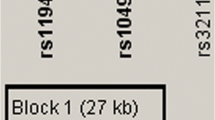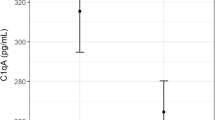Abstract
Tuberculosis (TB) caused by Mycobacterium tuberculosis, is major cause of morbidity and mortality worldwide. So far, many candidate genes have been investigated for their possible association with TB. Dendritic cell-specific intercellular adhesion molecule 3 (ICAM-3) grabbing non-integrin (DC-SIGN) and Liver/lymph node-specific intercellular adhesion molecule-grabbing non-integrin (L-SIGN), encoded by CD209 and CD209L genes respectively, are known for binding to M. tuberculosis on human dendritic cells and macrophages. We screened 4 single nucleotide polymorphisms (SNPs) in the promoter region of CD209, namely −939G>A (rs735240), −871A>G (rs735239), −336A>G (rs4804803) and −139G>A (rs2287886) and tandem repeat polymorphisms in exon 4 of CD209 and CD209L genes looking for association with TB in a Northeastern Brazilian population (295 subjects, 131 TB patients and 164 healthy controls). The −139G>A and −939G>A SNPs were associated with susceptibility to TB, and in particular with pulmonary and extra-pulmonary forms respectively. The −871A>G and −336A>G SNPs were associated, the first with protection to both pulmonary and extra-pulmonary TB, the latter only with the pulmonary form. An association between GGAG haplotype and protection to TB infection was also found. Also tandem repeat polymorphism in CD209L exon 4 was associated with TB infection. This study provides evidence of an association between CD209 and CD209L polymorphisms and TB development in a Brazilian population, suggesting that variations in these genes may influence the protection and susceptibility to infection caused by M. tuberculosis.
Similar content being viewed by others
References
World Health Organization (2010) Global tuberculosis control: surveillance, planning, financing. WHO report. WHO, Geneva
Hernandez-Pando R, Orozco H, Aguilar D (2009) Factors that deregulate the protective immune response in tuberculosis. Arch Immunol Ther Exp 57:355–367. doi:10.1007/s00005-009-0042-9
Tailleux L, Pham-Thi N, Bergeron-Lafaurie A et al (2005) DC-SIGN induction in alveolar macrophages defines privileged target host cells for Mycobacteria in patients with tuberculosis. PLoS Med 2(12):e381. doi:10.1371/journal.pmed.0020381
Khoo US, Chan KYK, Chan VSF, Lin CLS (2008) DC-SIGN and L-SIGN: the SIGNs for infection. J Mol Med 86:861–874. doi:10.1007/s00109-008-0350-2
Geijtenbeek TB, Torensma R, van Vliet SJ et al (2000) Identification of DC-SIGN, a novel dendritic cell-specific ICAM-3 receptor that supports primary immune responses. Cell 100(5):575–585. doi:10.1007/s00109-008-0350-2
Soilleux EJ, Barten R, Trowsdale J (2000) Cutting edge: DC-SIGN; a related gene, DC-SIGNR; and CD23 form a cluster on 19p13. J Immunol 165:2937–2942
Soilleux EJ, Morris LS, Leslie G et al (2002) Constitutive and induced expression of DC-SIGN on dendritic cell and macrophage subpopulations in situ and in vitro. J Leukoc Biol 71(3):445–457
Bashirova AA, Geijtenbeek TB, van Duijnhoven GC et al (2001) A dendritic cell-specific intercellular adhesion molecule 3-grabbing nonintegrin (DC-SIGN)-related protein is highly expressed on human liver sinusoidal endothelial cells and promotes HIV-1 infection. J Exp Med 193(6):671–678
Zhou T, Chen Y, Hao L, Zhang Y (2006) DC-SIGN and immunoregulation. Cell Mol Immunol 3(4):279–283
Boily-Larouche G, Zijenah LS, Mbizvo M, Ward BJ, Roger M (2007) DC-SIGN and DC-SIGNR genetic diversity among different ethnic populations: potential implications for pathogen recognition and disease susceptibility. Hum Immunol 68(6):523–530. doi:10.1016/j.humimm.2007.02.002
Selvaraj P, Alagarasu K, Swaminathan S, Harishankar M, Narendran G (2009) CD209 gene polymorphisms in South Indian HIV and HIV-TB patients. Infect Genet Evol 9(2):256–262. doi:10.1016/j.meegid.2008.12.003
World Health Organization (1998) Tuberculosis handbook. WHO, Geneva
Alves-Silva J, Da Silva Santos M, Guimarães PE (2000) The ancestry of Brazilian mtDNA lineages. Am J Hum Genet 67(2):444–461. doi:10.1086/303004
Alagarasu K, Selvaraj P, Swaminathan S, Raghavan S, Narendran G, Narayanan PR (2009) CCR2, MCP-1, SDF-1α & DC-SIGN gene polymorphisms in HIV-1 infected patients with & without tuberculosis. Indian J Med Res 130:444–450
Barreiro LB, Neyrolles O, Babb CL et al (2007) Length variation of DC-SIGN and L-SIGN neck-region has no impact tuberculosis susceptibility. Hum Immunol 68(2):106–112
Rathore A, Chatterjee A, Sivarama P, Yamamoto N, Dhole TN (2008) Role of homozygous DC-SIGNR 5/5 tandem repeat polymorphism in HIV-1 exposed seronegative north Indian individuals. J Clin Immunol 28(1):50–57
Ben-Ali M, Barreiro LB, Chabbou A et al (2007) Promoter and neck region length variation of DC-SIGN is not associated with susceptibility to tuberculosis in Tunisian patients. Hum Immunol 68(11):908–912
Excoffier L, Laval G, Schneider S (2005) Arlequin (version 3.0): an integrated software package for population genetics data analysis. Evol Bioinform Online 1:47–50
R Development Core Team (2010) R: a language and environment for statistical computing. Viena
Solé X, Guinó E, Valls J, Iniesta R, Moreno V (2006) SNPStats: a web tool for the analysis of association studies. Bioinformatics 22(15):1928–1929
Liu H, Yu W, Liou LY, Rice AP (2003) Isolation and characterization of the human DC-SIGN and DC-SIGNR promoters. Gene 313:149–159
Sakuntabhai A, Turbpaiboon C, Casadémont I et al (2005) A variant in the CD209 promoter is associated with severity of dengue disease. Nat Genet 37(5):507–513
Sainz J, Segura-Catena J, Jura do M (2010) Association between genetic polymorphism in the promotor region off CD209 and propensity to develop invasive pulmonary aspergillosis. Methods Find Exp Clin Pharmacol 32(Suppl A):9–13
Kashima S, Rodrigues ES, Azevedo R et al (2009) DC-SIGN (CD209) gene promoter polymorphisms in a Brazilian population and their association with human T-cell lymphotropic virus type 1 infection. J Gen Virol 90(Pt 4):927–934
Barkhash AV, Perelygin AA, Babenko VN, Brinton MA, Voevoda MI (2012) Single nucleotide polymorphism in the promoter region of the CD209 gene is associated with human predisposition to severe forms of tick-borne encephalitis. Antiviral Res 93(1):64–68
Mezger M, Steffens M, Semmler C et al (2008) Investigation of promoter variations in dendritic cell-specific ICAM3-grabbing non-integrin (DC-SIGN) (CD209) and their relevance for human cytomegalovirus reactivation and disease after allogeneic stem-cell transplantation. Clin Microbiol Infect 14(3):228–234
Vannberg FO, Chapman SJ, Khor CC et al (2008) CD209 genetic polymorphism and tuberculosis disease. PLoS One 3(1):e1388
Barreiro LB, Neyrolles O, Babb CL et al (2006) Promoter variation in the DC-SIGN-encoding gene CD209 is associated with tuberculosis. PLoS Med 3(2):e20
Gómez LM, Anaya JM, Sierra-Filardi E, Cadena J, Corbi A, Martín J (2006) Analysis of DC-SIGN (CD209) functional variants in patients with tuberculosis. Hum Immunol 67(10):808–811
Zheng J, Zhou Y, Qin L et al (2011) Relationship between polymorphism of DC-SIGN (CD209) gene and the susceptibility to pulmonary tuberculosis in an eastern Chinese population. Hum Immunol 72(2):183–186
Kobayashi K, Yuliwulandari R, Yanai H, Lien LT, Hang NT, Hijikata M, Keicho N, Takunaga K (2011) Association of CD209 polymorphisms with tuberculosis in an Indonesian population. Hum Immunol 72(9):741–745
The International HapMap Consortium (2005) A haplotype map of the human genome. Nature 437:1299–1320
Xu L, Li Q, Ye H et al (2010) The nine-repeat DC-SIGNR isoform is associated with increased HIV-RNA loads and HIV sexual transmission. J Clin Immunol 30(3):402–407
Guo Y, Atkinson CE, Taylor ME, Drickamer K (2006) All but the shortest polymorphic forms of the viral receptor DC-SIGNR assemble into homo- and heterotetramers. J Biol Chem 281(24):16794–16798
Gramberg T, Zhu T, Chaipan C et al (2006) Impact of polymorphisms in the DC-SIGNR neck domain on the interaction with pathogens. Virology 347:354–363
Acknowledgments
We thank the Laboratory of Immunopathology Keizo Asami, the Department of Genetics, Federal University of Pernambuco, the Graduate Program in Genetics for supporting physical and scientific, as well as FACEPE and CNPq, for financial support. We thank the Program for Technological Development in Tools for Health-PDTIS/FIOCRUZ for use of its facilities.
Conflict of interest
None of the authors has any potential financial conflict of interest related to this manuscript.
Author information
Authors and Affiliations
Corresponding author
Rights and permissions
About this article
Cite this article
da Silva, R.C., Segat, L., da Cruz, H.L.A. et al. Association of CD209 and CD209L polymorphisms with tuberculosis infection in a Northeastern Brazilian population. Mol Biol Rep 41, 5449–5457 (2014). https://doi.org/10.1007/s11033-014-3416-y
Received:
Accepted:
Published:
Issue Date:
DOI: https://doi.org/10.1007/s11033-014-3416-y




